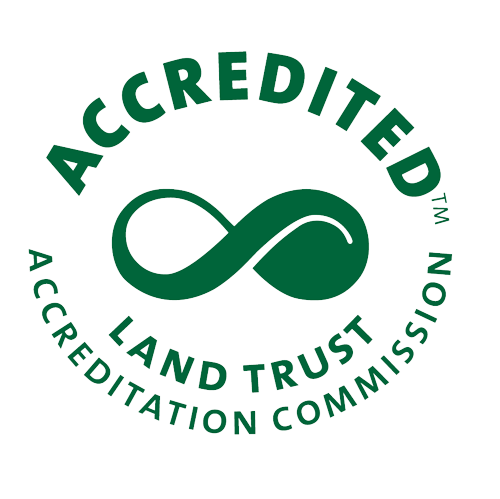
501(c)(3)
Appraisal
Real estate appraisal, property valuation or land valuation is the process of developing an opinion of value for real property (usually market value). Real estate transactions often require appraisals because they occur infrequently and every property is unique (especially their condition, a key factor in valuation). The location also plays a key role in valuation. However, since property cannot change location, it is often the upgrades or improvements that can change its value. Appraisal reports form the basis for mortgage loans, settling estates and divorces, taxation, and so on. Sometimes an appraisal report is used to establish a sale price for a property.
Bargain Sale
Baseline Documentation Report
Conservation Easement
A legal agreement between a landowner and a conservation organization that permanently prevents residential development and limits a property’s uses in order to protect its conservation values.
Conservation Easement Stewardship
When a conservation easement is donated or sold to Sakonnet Preservation the landowner, not Sakonnet Preservation, continues to own and manage the land subject to the easement’s restrictions. Sakonnet Preservation’s responsibility is to monitor each easement annually to ensure that management by the owner conforms to the agreement.
Conservation Purposes (values)
Contiguous Parcel Rule – Treasury Regulation Rules
- Rule #1: The Donor/Family Contiguous Parcel Rule of Treasury Regulation §1.170A-I4(h)(3)(i) states: The amount of the deduction in the case of a charitable contribution of a perpetual conservation restriction covering a portion of the contiguous property owned by a donor and the donor’s family (as defined in section 267(c)(4)) is the difference between the fair market value of the entire contiguous parcel of property before and after the granting of the restriction.
- Rule #2: The Other Property/Related Person Rule of Treasury Regulation §1.170A-l4(h)(3)(i) states: If the granting of a perpetual conservation restriction after January 14, 1986, has the effect of increasing the value of any other property owned by the donor or a related person, the amount of the deduction for the conservation contribution shall be reduced by the amount of the increase in the value of the other property, whether or not such property is contiguous.
Due Diligence
Easement Enforcement (or defense)
Actions taken by a land trust to uphold the easement when an easement is violated, including, for example, legal action and restoration of conservation values.
Encroachment
A building, other improvement or some portion of it — a wall or fence, for instance — or other non-permitted use that extends beyond the land of one owner and intrudes on land of an adjoining owner.
Fee Simple Interest
Outright ownership of property to a conservation organization.
Fee Property Stewardship
Sakonnet Preservation is fully responsible for the management and annual monitoring of each properties it owns to ensure its conservation values are protected.
Grantee
A person who receives a conveyance of real property from a grantor.
Grantor
The person transferring title to or an interest in real property to a grantee.
Improvement
Or
Invasive species
Also called non-native, alien, exotic or introduced species; those species that evolved elsewhere and have been purposely or accidentally relocated into a new area by humans. Invasive species often find no natural enemies in their new habitat and therefore spread easily and quickly.
IRS Form 8282
Donee Information Return. If the land trust sells or transfers donated property valued at more than $5,000 within three years of the date the original donee received the property, the land trust must file Form 8282, notifying the IRS of the disposition.
IRS Form 8283
Non-cash Charitable Contributions. A donor must attach Form 8283 to an income tax return to claim a deduction for a gift of a conservation easement or land valued more than $500. The 8283 will also need to be signed by the land trust accepting the gift.
IRS Form 990
Form 990 and Form 990-EZ are used by tax-exempt organizations, nonexempt charitable trusts and section 527 political organizations to provide the IRS with the annual financial information required by section 6033. Organizations with gross receipts of less than $100,000 and assets of less than $25,000 at the end of the year can use the EZ form.
Management Plan
A biologist helps develop a plan for appropriately managing a fee property for our organization in order to best protect the property’s conservation values. The plan is implemented and monitored by our Stewardship Committee volunteers and is filed in the property’s stewardship notebook in our office.
Legal defense fund (also known as enforcement fund)
Metes-and-bounds description
A legal description of a parcel of land that begins at a well-marked point and follows the boundaries, using directions and distances around the tract, to the point of beginning.
Monitoring
A set of procedures for gauging or tracking specific environmental parameters or attributes over time, such that the results can be compared to some standard or detect directional change.
Mortgage Subordination
If a conservation easement is placed on a property with an existing mortgage, the easement is at risk of being dissolved in the event of a mortgage foreclosure. Unless the lender legally commits to leaving the conservation easement intact, the easement’s public benefits —and any public funds or private donations invested in the easement – could be lost.
A mortgage also prohibits landowners from claiming federal income tax deductions for an easement donation “unless the mortgagee subordinates its rights in the property to the right of the qualified organization to enforce the conservation purposes of the gift in perpetuity,” according to Internal Revenue Code 170A-14(g)(2).
A mortgage subordination is an agreement in which a mortgage holder consents to give a conservation easement priority over the mortgage, although the mortgage was recorded prior to the easement. A lien or claim on the property is generally prioritized by the order in which it was recorded in the land records, as shown in a title search. “First in time; first in right” is generally the rule. Unless a previously recorded mortgage was subordinated to the conservation easement, and the subordination agreement was recorded immediately prior to the conservation easement, the conservation easement may be automatically extinguished if the lender forecloses on the mortgaged property.
Phase I assessment
A formal investigation conducted by a qualified environmental consultant or engineer into the presence or absence of hazardous materials on or near a property that satisfies the “all appropriate inquiries” rule of the Environmental Protection Agency.
Private benefit
This benefit occurs when a tax-exempt organization provides more than an “incidental” benefit to a non-insider. Although charitable organizations such as land trusts may provide benefits to private individuals, federal tax-exempt law prohibits more than an “incidental” benefit. The IRS prohibition on private benefit is absolute. Incidental benefits are considered to be those benefits that are insubstantial when measured in the context of the overall public benefit conferred by the activity. Incidental benefits occur as part of the nonprofit’s public purpose and activity, which cannot be achieved without benefiting some private individuals. For example, the incidental benefits to an adjoining property owner that typically result from a conservation easement both fall within the land trust’s mission and are insubstantial in the context of the overall benefit of protecting the property. Such incidental benefits to the adjoining property owner would not be considered a private benefit.
Private inurement
When the net earnings of a tax-exempt organization come to the benefit of any private shareholder or individual. Federal tax-exempt law requires that “no part of . . . [a tax-exempt organization’s] net earnings [may] inure to the benefit of any private shareholder or individual.” An action in which a person who is an “insider” to the tax-exempt organization, such as a director or an officer, derives a benefit from the organization without giving something of at least equal value in return. The IRS prohibition on inurement is absolute. The IRS also imposes penalties on directors, officers, key employees, and other insiders who engage in transactions that confer an excess benefit on the individual (“excess benefit transactions”).
Qualified appraisal
An appraisal that satisfies §170(f)(11)(E)(ii) of the Internal Revenue Code and §1.170A-13(c) of the Treasury Regulations.
Qualified conservation contribution
A charitable donation that satisfies §170(h) of the Internal Revenue Code.
Qualified conservation easement
A qualified conservation contribution that meets the additional requirements of §2031(c) of the Internal Revenue Code.
Qualified independent appraisal
An independent appraisal prepared in compliance with the Uniform Standards of Professional Appraisal Practice by a state-licensed or state-certified appraiser who has verifiable conservation easement or conservation real estate experience.
Reserved rights
The rights to use or develop the property reserved by the landowner under the terms of the conservation easement. The term can also include a reference to activities permitted on a property, and to the rights reserved to use the land for agricultural, forestry, or other working lands purposes.
Stewardship
Those steps necessary to uphold a conservation easement in perpetuity, including the creation of baseline documentation, regular monitoring, maintaining landowner relations including successor generation landowners, addressing amendments, and easements enforcements; or the steps necessary to undertake the many responsibilities of managing a fee-owned property in perpetuity.
Title report
The purpose of the “title search” is to a) provide a legal property description and b) identify encumbrances on the property such as underlying mortgages and liens, etc.
Trade lands
Properties, usually with low or no conservation value, donated with the expectation they would be sold to generate revenue for the land trust.




